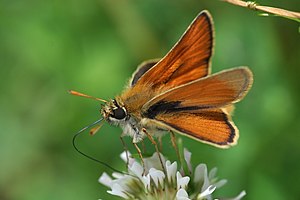Brown-piston brown thick-headed butterfly
| Brown-piston brown thick-headed butterfly | ||||||||||||
|---|---|---|---|---|---|---|---|---|---|---|---|---|

Brown-eared brown thick-headed butterfly ( Thymelicus sylvestris ) |
||||||||||||
| Systematics | ||||||||||||
|
||||||||||||
| Scientific name | ||||||||||||
| Thymelicus sylvestris | ||||||||||||
| ( Poda , 1761) |
The brown ocher or ocher brown thick-headed butterfly ( Thymelicus sylvestris ) is a butterfly from the family of the thick-headed butterfly (Hesperiidae).
features
The moths reach a wingspan of 27 to 34 millimeters. They have light orange-brown colored wing tops, the wing veins are clearly visible. The edge of the wing is dark brown. The underside of the wing is colored greenish-gray at the tip of the fore wing and almost over the entire surface of the hind wing. On the underside of the hind wings, the inner margin is broadly lined with yellow. In contrast to the similar black-headed brown thick-headed butterfly ( Thymelicus lineola ), the undersides of the bulb are yellow-brown in color. The male's dark scented scent is narrow but clearly recognizable.
The caterpillars are 20 to 25 millimeters long. They have a whitish-green colored body, with several light vertical stripes, the head capsule is green.
Similar species
- Black-spotted brown thick-headed butterfly ( Thymelicus lineola )
- Matt-spotted brown thick-headed butterfly ( Thymelicus acteon )
Occurrence
The animals are found in North Africa and almost all of Europe . However, they are missing in the Balearic Islands , Corsica , Sardinia and Crete , as well as in the north of the British Isles and in the far north of Scandinavia . In the vertical distribution one finds the butterfly from the lowlands up to about 1900 meters, in North Africa also up to 2.600 meters above sea level. You can find them in flower-filled forest clearings and bushes with tall grass, as well as on the edges of forests and roads, embankments, the edges of dry grassland and railway embankments. There is a close connection to hem structures, but in contrast to the matt-pecked brown thick-headed butterfly, fresher areas are preferred. The moths are sometimes found in large numbers.
Way of life
The animals like to sit on knapweed ( Centaurea ) and suck nectar. The males are very active and defend territories against other butterflies. The females, on the other hand, are calmer.
Flight and caterpillar times
The moths fly in one generation from late June to August. The caterpillars can be found from September and after wintering until May.
Food of the caterpillars
The caterpillars feed on various grasses, among others, Woolly honey grass ( Holcus lanatus ), Soft honey grass ( Holcus mollis ), timothy grass ( Phleum pratense ) and Brachypodium sylvaticum ( Brachypodium sylvaticum ).
development
The females lay their yellowish-green, oval eggs in groups of 20 to 40 on the leaf sheaths of dry grass stems. Before doing this, the plants are carefully examined for 10 to 15 minutes. After about 16 to 23 days, the caterpillars hatch, eat the egg shell and spin an egg cocoon to overwinter on the forage plant. They do not begin to eat the forage plants until the next spring. They spin the long sides of the blades of grass together and live as solitary animals protected on the inside. Only when they are a little bigger do they also eat outside. Pupation takes place in a loose web between blades of grass.
The pupa is 16 to 20 millimeters long and colored pale green. In contrast to Thymelicus lineola , you can see the protruding proboscis sheath. The moths hatch after 12 to 18 days.
supporting documents
Individual evidence
- ↑ a b Tom Tolman, Richard Lewington: The butterflies of Europe and North West Africa , p. 271, Franckh-Kosmos Verlags-GmbH & Co, Stuttgart 1998, ISBN 3-440-07573-7
- ↑ a b Hans-Josef Weidemann: Tagfalter: watch, determine , p. 618ff, Naturbuch-Verlag Augsburg 1995, ISBN 3-89440-115-X
- ↑ Manfred Koch : We identify butterflies. Volume 1: Butterfly. 4th enlarged edition. Neumann, Radebeul / Berlin 1966, DNB 457244224 , pp. 120f.
literature
- Günter Ebert, Erwin Rennwald: The butterflies of Baden-Württemberg, Volume 2, Tagfalter II. Ulmer Verlag Stuttgart 1993. ISBN 3-8001-3459-4
Web links
- Lepiforum e. V. Taxonomy and Photos
- www.schmetterling-raupe.de
- UK Butterflies (English)
- Moths and Butterflies of Europe and North Africa (English)
- Thymelicus sylvestris at Fauna Europaea

